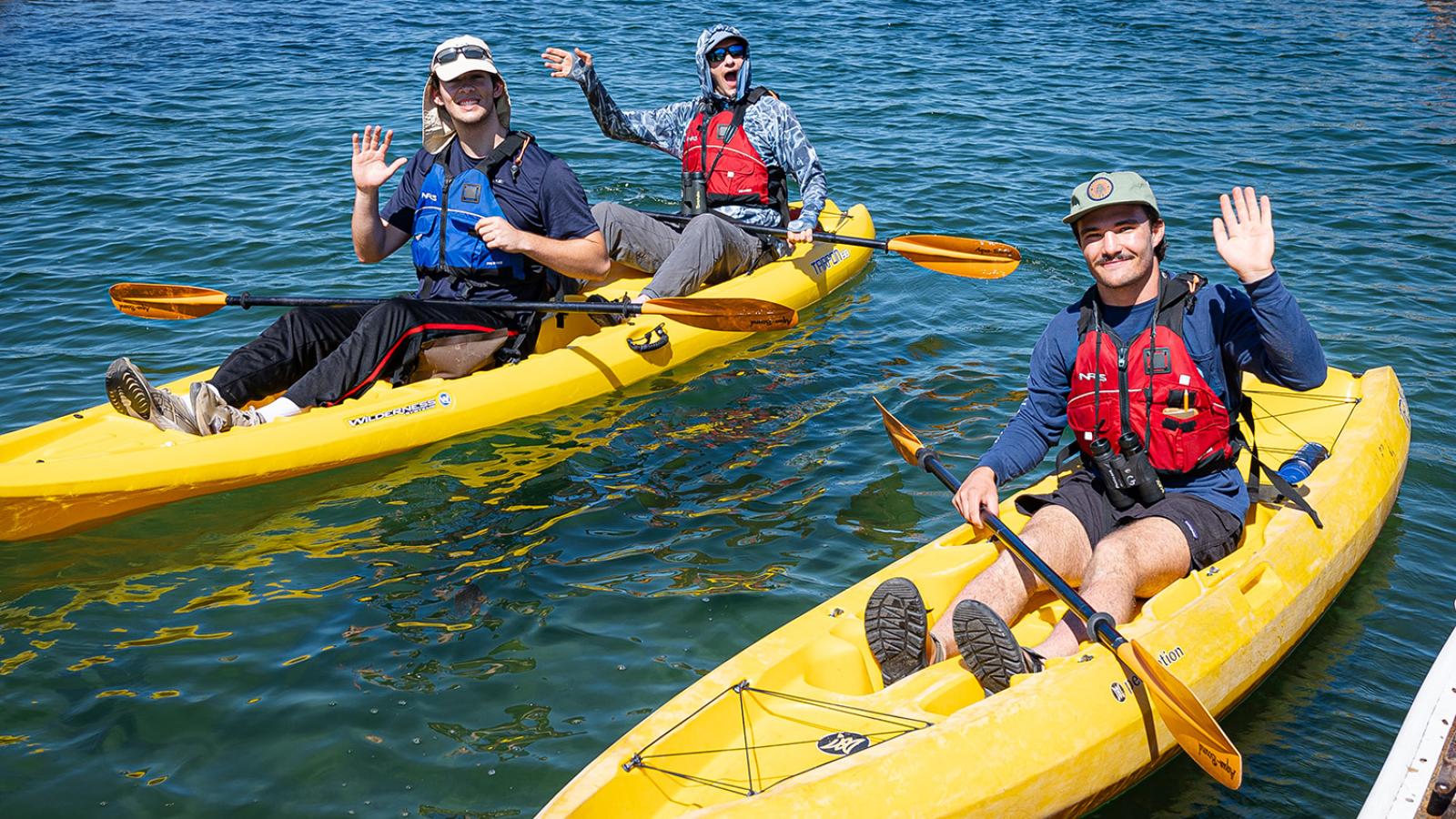Thomas Amory ’27 and Max Distaso ’28 are spending their summer kayaking off Dana Point and Redondo Beach in search of banded pelicans; catching and assessing the diet of American bullfrogs at the Bernard Field Station’s pHake Lake; and measuring huts constructed by two native species of woodrat.
The biology majors are working in the lab of Nina Karnovsky, Willard George Halstead Zoology Professor of Biology, in the Pomona College Summer Undergraduate Research Program (SURP), which provides experiential learning in a variety of disciplines and includes a stipend of $720 per week.
“The opportunity for us to do something like this as undergraduates is amazing, right?” says Amory, a rising junior from Seattle aiming for a career in medicine. “I feel a bit like an explorer, like I’m Indiana Jones.”
Both Amory and Distaso reached out to Karnovsky about a place in her lab this summer while enrolled in her Introductory Ecology and Evolutionary Biology class spring semester. “I’ve always had an interest in conservation,” says Distaso, who hails from La Verne, a few miles from campus. “I think a lot of that stems from growing up spending a lot of time outside and getting to see really cool environments in California.”
Karnovsky has been carrying out Project W.I.L.D.—Wildlife Investigations of Local Diversity—with students in the summer for more than two decades. Much of the research occurs at the Bernard Field Station, which is located on 85 acres north of Foothill Boulevard in Claremont and is home to some of the last remaining California sage scrub habitat in the area.
“In 2005, we mapped the hut structures of woodrats at the field station,” Karnovsky says. “Then we remapped the area in 2022 after it had experienced two fires. Now, in 2025, Thomas and Max are revisiting this map built by other students to see if the huts are there and if they are still occupied.”
Woodrats are not the type of pest that invade human spaces. Karnovsky describes them as “cute,” with furry tails. “They build these beautiful houses,” she says, sometimes placing fresh plant clippings on top of them for a reason yet unknown. Some of the dwellings are so old, she told students, that historic Spanish coins have been found inside.
Once the students find a hut, they put out heat-sensing trail cameras to see which are still in use. “So at night, when the animal comes out, the infrared light picks up that there’s something living there and it takes pictures,” Karnovsky says.
Woodrats are an important part of the ecosystem. “This survey of huts gives us a better idea of how the population specifically at the field station is doing,” Distaso explains.
Karnovsky believes that collaboration with other researchers is an important skill for young scientists to cultivate. When they aren’t investigating the woodrat populations, Amory and Distaso are working with a graduate student from Cal Poly Pomona on a study of bullfrogs at the field station. The research will examine the impact the frogs, an invasive species, are having on diversity around pHake Lake.
Earlier this summer, the Pomona students dissected a bullfrog’s stomach and found a newly hatched Western Pond turtle, a species listed as of special concern. The discovery “shows that these invasive species are negatively affecting rare native species,” says Amory.
Another collaboration, with the non-profit Pelican Science, connected the students with a researcher from the Scripps Institute of Oceanography at UC San Diego. Brown pelicans sometimes experience physical trauma from humans or are poisoned by naturally occurring algae blooms, says Karnovsky. A network of researchers places a small, numbered radio band on the leg of pelicans that are rescued and rehabilitated. When they fly near one of the radio towers the researchers have placed across the country, their location is registered.
In July, Amory and Distaso kayaked around two Southern California beaches that pelicans frequent. They used binoculars to search for any wearing bands while the researcher carried an antenna to pick up signals and log their locations.
“This is really important data,” says Karnovsky. The pelicans “are one of very few animals that have been taken off the endangered species list. How did that happen? It’s still really important to monitor what’s happening to them.”
“We saw upwards of 400 pelicans, so they are doing well in the area,” says Distaso. A large group of sea lions is thriving there as well. Finding them “was quite the fun experience,” Amory adds.
Amory and Distaso will be among the 241 SURP students reporting on their summer research findings at the Intensive Summer Experience Poster Conference on campus in late September. They will also present their bird-related summer research at the September meeting of the Pomona Valley Audubon Society.
“It’s a good experience for them,” Karnovsky believes. “You need to do science—collect data, analyze data, present it to other scientists. But you also have to be able to communicate that to non-scientists.”
Eight weeks into a 10-week summer research project, Distaso remains enthusiastic about what he’s learning. “It’s really amazing that we get to work with so many different species and learn all these different techniques,” he says. “I feel like it’s a very rare opportunity that I’ve only heard of happening at Pomona.”
